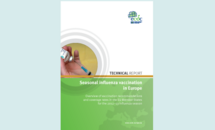Seasonal influenza vaccination in Europe – Vaccination recommendations and coverage rates for 2012–13
Reaching high influenza vaccination coverage rates for those at risk of developing severe complications due to influenza infection remains a considerable challenge, concludes a new ECDC report that provides an overview of seasonal influenza vaccination policies and vaccination coverage rates in the EU/EEA for the 2012–13 influenza season.
Executive Summary
Reaching high influenza vaccination coverage rates for those at risk of developing severe complications due to influenza infection remains a considerable challenge, concludes the new ECDC report that provides an overview of seasonal influenza vaccination policies and vaccination coverage rates in the EU/EEA for the 2012–13 influenza season.
This report is based on a survey of 31 Member States, conducted in collaboration with the Vaccine European New Integrated Collaboration Effort III (VENICE III). Where feasible, data for the 2012-13 influenza season are compared to results of the previous influenza season, 2011-12.
Vaccination remains the most effective public health intervention to mitigate and prevent seasonal influenza. In 2009, the European Council adopted a recommendation that influenza vaccination coverage in at-risk groups should reach 75% in all EU countries by the 2014–15 influenza season.
Results of the survey show that it is common for European countries to have recommendations for seasonal influenza vaccination for targeted or at-risk groups, such as older people, pregnant women, those with chronic medical conditions and healthcare workers.
At the same time, vaccination coverage rates for various target groups vary widely across Europe. For example, vaccination coverage rates for older age groups vary from 1% to 77%, with only a handful of countries reaching or nearly reaching the 75% goal set by the Council Recommendation. With a few exceptions, this rate is stagnant or even decreasing compared to data from the previous season. A similarly wide range of vaccination coverage rates, from 9.5% to 75%, can be observed for the 13 countries reporting vaccination rates among healthcare workers.
The ability to monitor vaccination coverage is a key component of any vaccination programme and helps identify gaps and weaknesses. A notable discrepancy between having recommendations and being able to monitor vaccination coverage can be observed across Europe. Although all European countries recommend seasonal influenza vaccination for people with chronic medical conditions, data about the vaccine coverage rates for this group are available only in seven of the reporting countries. Less than half of the reporting countries have vaccine coverage data for healthcare workers, although almost all countries recommend vaccination for this group.
The report makes note of positive changes, such as the fact that more countries have been able to provide information about vaccination coverage rates for groups such as healthcare workers and pregnant women, and proposes a number of recommendations as a way forward to achieve higher vaccination rates and improved monitoring.
Download
Publication data
Country profile
Seasonal influenza vaccination recommendations and coverage rates, 2012–13 - Country profile for Austria
Seasonal influenza vaccination in Europe – Vaccination recommendations and coverage rates, 2012–13 - Country profile for Austria
Country profile
Seasonal influenza vaccination recommendations and coverage rates, 2012–13 - Country profile for Belgium
Seasonal influenza vaccination recommendations and coverage rates, 2012–13 - Country profile for Belgium
Country profile
Seasonal influenza vaccination recommendations and coverage rates, 2012–13 - Country profile for Bulgaria
Seasonal influenza vaccination recommendations and coverage rates, 2012–13 - Country profile for Bulgaria
Country profile
Seasonal influenza vaccination recommendations and coverage rates, 2012–13 - Country profile for Croatia
Seasonal influenza vaccination recommendations and coverage rates, 2012–13 - Country profile for Croatia
Country profile
Seasonal influenza vaccination recommendations and coverage rates, 2012–13- Country profile for Cyprus
Seasonal influenza vaccination recommendations and coverage rates, 2012–13- Country profile for Cyprus
Country profile
Seasonal influenza vaccination recommendations and coverage rates, 2012/13 - Country profile for Czech Republic
Seasonal influenza vaccination recommendations and coverage rates, 2012/13 - Country profile for Czech Republic
Country profile
Seasonal influenza vaccination recommendations and coverage rates, 2012/13- Country profile for Denmark
Seasonal influenza vaccination recommendations and coverage rates, 2012/13- Country profile for Denmark
Country profile
Seasonal influenza vaccination recommendations and coverage rates, 2012/13 - Country profile for England
Seasonal influenza vaccination recommendations and coverage rates, 2012/13 - Country profile for England
Country profile
Seasonal influenza vaccination recommendations and coverage rates, 2012/13 - Country profile for Estonia
Seasonal influenza vaccination recommendations and coverage rates, 2012/13 - Country profile for Estonia
Country profile
Seasonal influenza vaccination recommendations and coverage rates, 2012/13 - Country profile for Finland
Seasonal influenza vaccination recommendations and coverage rates, 2012/13 - Country profile for Finland
Country profile
Seasonal influenza vaccination recommendations and coverage rates, 2012/13 - Country profile for France
Seasonal influenza vaccination recommendations and coverage rates, 2012/13 - Country profile for France
Country profile
Seasonal influenza vaccination recommendations and coverage rates, 2012/13 - Country profile for Germany
Seasonal influenza vaccination recommendations and coverage rates, 2012/13 - Country profile for Germany
Country profile
Seasonal influenza vaccination recommendations and coverage rates, 2012/13 - Country profile for Greece
Seasonal influenza vaccination recommendations and coverage rates, 2012/13 - Country profile for Greece
Country profile
Seasonal influenza vaccination recommendations and coverage rates, 2012/13 - Country profile for Hungary
Seasonal influenza vaccination recommendations and coverage rates, 2012/13 - Country profile for Hungary
Country profile
Seasonal influenza vaccination recommendations and coverage rates, 2012/13 - Country profile for Iceland
Seasonal influenza vaccination recommendations and coverage rates, 2012/13 - Country profile for Iceland
Country profile
Seasonal influenza vaccination recommendations and coverage rates, 2012/13 - Country profile for Ireland
Seasonal influenza vaccination recommendations and coverage rates, 2012/13 - Country profile for Ireland
Country profile
Seasonal influenza vaccination recommendations and coverage rates, 2012/13 - Country profile for Italy
Seasonal influenza vaccination recommendations and coverage rates, 2012/13 - Country profile for Italy
Country profile
Seasonal influenza vaccination recommendations and coverage rates, 2012/13 - Country profile for Latvia
Seasonal influenza vaccination recommendations and coverage rates, 2012/13 - Country profile for Latvia
Country profile
Seasonal influenza vaccination recommendations and coverage rates, 2012/13 - Country profile for Liechtenstein
Seasonal influenza vaccination recommendations and coverage rates, 2012/13 - Country profile for Liechtenstein
Country profile
Seasonal influenza vaccination recommendations and coverage rates, 2012/13 - Country profile for Lithuania
Seasonal influenza vaccination recommendations and coverage rates, 2012/13 - Country profile for Lithuania
Country profile
Seasonal influenza vaccination recommendations and coverage rates, 2012/13 - Country profile for Luxembourg
Seasonal influenza vaccination recommendations and coverage rates, 2012/13 - Country profile for Luxembourg
Country profile
Seasonal influenza vaccination recommendations and coverage rates, 2012/13 - Country profile for Malta
Seasonal influenza vaccination recommendations and coverage rates, 2012/13 - Country profile for Malta
Country profile
Seasonal influenza vaccination recommendations and coverage rates, 2012/13 - Country profile for Netherlands
Seasonal influenza vaccination recommendations and coverage rates, 2012/13 - Country profile for Netherlands
Country profile
Seasonal influenza vaccination recommendations and coverage rates, 2012/13 - Country profile for Northern Ireland
Seasonal influenza vaccination recommendations and coverage rates, 2012/13 - Country profile for Northern Ireland
Country profile
Seasonal influenza vaccination recommendations and coverage rates, 2012/13 - Country profile for Norway
Seasonal influenza vaccination recommendations and coverage rates, 2012/13 - Country profile for Norway
Country profile
Seasonal influenza vaccination recommendations and coverage rates, 2012/13 - Country profile for Poland
Seasonal influenza vaccination recommendations and coverage rates, 2012/13 - Country profile for Poland
Country profile
Seasonal influenza vaccination recommendations and coverage rates, 2012/13 - Country profile for Portugal
Seasonal influenza vaccination recommendations and coverage rates, 2012/13 - Country profile for Portugal
Country profile
Seasonal influenza vaccination recommendations and coverage rates, 2012/13 - Country profile for Romania
Seasonal influenza vaccination recommendations and coverage rates, 2012/13 - Country profile for Romania
Country profile
Seasonal influenza vaccination recommendations and coverage rates, 2012/13 - Country profile for Scotland
Seasonal influenza vaccination recommendations and coverage rates, 2012/13 - Country profile for Scotland
Country profile
Seasonal influenza vaccination recommendations and coverage rates, 2012/13 - Country profile for Slovakia
Seasonal influenza vaccination recommendations and coverage rates, 2012/13 - Country profile for Slovakia
Country profile
Seasonal influenza vaccination recommendations and coverage rates, 2012/13 - Country profile for Slovenia
Seasonal influenza vaccination recommendations and coverage rates, 2012/13 - Country profile for Slovenia
Country profile
Seasonal influenza vaccination recommendations and coverage rates, 2012/13 - Country profile for Spain
Seasonal influenza vaccination recommendations and coverage rates, 2012/13 - Country profile for Spain
Country profile
Seasonal influenza vaccination recommendations and coverage rates, 2012/13 - Country profile for Sweden
Seasonal influenza vaccination recommendations and coverage rates, 2012/13 - Country profile for Sweden
Country profile
Seasonal influenza vaccination recommendations and coverage rates, 2012/13 - Country profile for Wales
Seasonal influenza vaccination recommendations and coverage rates, 2012/13 - Country profile for Wales








